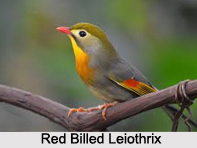 Red-Billed Leiothrix is an Indian Bird that bears a scientific name "Leiothrix lutea" residing in the Indian states like Himalayan Mountain Range, Himachal Pradesh, Assam, Mizoram, and Meghalaya, Sikkim.
Red-Billed Leiothrix is an Indian Bird that bears a scientific name "Leiothrix lutea" residing in the Indian states like Himalayan Mountain Range, Himachal Pradesh, Assam, Mizoram, and Meghalaya, Sikkim.
Category of Red-Billed Leiothrix
Red-Billed Leiothrix is a member of the Leiothrichidae family, and is native to the Indian states.
Structure of Red-Billed Leiothrix
The adult Red-Billed Leiothrix have bright red bills and a dull yellow ring around their eyes. Their backs are dull olive green, and they have a bright yellow-orange throat with a yellow chin; females are somewhat duller than males, and juveniles have black bills.
Introduction of Red-Billed Leiothrix
It has also been introduced in various parts of the world, with small populations of escapees having existed in Japan since the 1980s. It has become a common Cagebird and amongst aviculturists it goes by various names: Pekin robin, Pekin nightingale, Japanese nightingale and Japanese (hill) robin, the last two being misnomers as it is not native to Japan.
Structure of Red-Billed Leiothrix
Red-Billed Leiothrix is about six inches in length, generally olive green, and has a yellow throat with orange shading on the breast. It also has a dull yellowish ring around the eye that extends to the beak. The edges of the wing feathers are brightly coloured with yellow, orange, red and black and the forked tail is olive brown and blackish at the tip. The cheeks and side of the neck are bluish grey in colour. The female is a lot paler than the male and lacks the red patch on the wings. It does not fly frequently, except in open habitats.
Behaviour of Red-Billed Leiothrix
Red-Billed Leiothrix is very active and an excellent singer but very secretive and difficult to see.
Concentration of Red-Billed Leiothrix
Red-Billed Leiothrix is usually found in India, Bhutan, Nepal, Burma and parts of Tibet. This species is a bird of the hill forests, found in every type of jungle though it prefers pine forests with bushes. It has also been found at elevations ranging from near sea level to about 7,500 feet.
Feeding of Red-Billed Leiothrix
Red-Billed Leiothrix feeds on animal matter. It eats fruits such as strawberries, ripened papaya, guavas and also various species of Diptera, Mollusca, Lepidoptera, and Hymenoptera. Its food is usually gathered from foliage and dead wood and it usually searches for food in lower strata of vegetation.
Groups of Red-Billed Leiothrix
Red-Billed Leiothrix can usually be found in a group of about ten to thirty birds during the non-breeding season; however, during the breeding season the birds break off into pairs and become territorial. These birds have a song which consists of short powerful notes that are repeated continuously throughout the year but it is more persistent during the breeding season. This period usually lasts from early April until September and they are usually found around well watered areas. The males sing long complex songs with a wide array of syllables to attempt to attract the female.



















